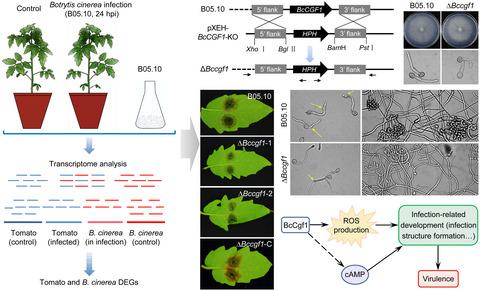当前位置:
X-MOL 学术
›
Mol. Plant Pathol.
›
论文详情
Our official English website, www.x-mol.net, welcomes your
feedback! (Note: you will need to create a separate account there.)
Transcriptome analysis and functional validation reveal a novel gene, BcCGF1, that enhances fungal virulence by promoting infection-related development and host penetration.
Molecular Plant Pathology ( IF 4.8 ) Pub Date : 2020-04-16 , DOI: 10.1111/mpp.12934 Ming-Zhe Zhang 1 , Chen-Hao Sun 2 , Yue Liu 1 , Hui-Qiang Feng 1 , Hao-Wu Chang 3 , Sheng-Nan Cao 2 , Gui-Hua Li 2 , Song Yang 2 , Jie Hou 2, 4 , Keyan Zhu-Salzman 5 , Hao Zhang 3 , Qing-Ming Qin 1
Molecular Plant Pathology ( IF 4.8 ) Pub Date : 2020-04-16 , DOI: 10.1111/mpp.12934 Ming-Zhe Zhang 1 , Chen-Hao Sun 2 , Yue Liu 1 , Hui-Qiang Feng 1 , Hao-Wu Chang 3 , Sheng-Nan Cao 2 , Gui-Hua Li 2 , Song Yang 2 , Jie Hou 2, 4 , Keyan Zhu-Salzman 5 , Hao Zhang 3 , Qing-Ming Qin 1
Affiliation

|
Simultaneous transcriptome analyses of both host plants and pathogens, and functional validation of the identified differentially expressed genes (DEGs) allow us to better understand the mechanisms underlying their interactions. Here, we analyse the mixed transcriptome derived from Botrytis cinerea (the causal agent of grey mould) infected tomato leaves at 24 hr after inoculation, a critical time point at which the pathogen has penetrated and developed in the leaf epidermis, whereas necrotic symptoms have not yet appeared. Our analyses identified a complex network of genes involved in the tomato–B. cinerea interaction. The expression of fungal transcripts encoding candidate effectors, enzymes for secondary metabolite biosynthesis, hormone and reactive oxygen species (ROS) production, and autophagy‐related proteins was up‐regulated, suggesting that these genes may be involved in the initial infection processes. Specifically, tomato genes involved in phytoalexin production, stress responses, ATP‐binding cassette transporters, pathogenesis‐related proteins, and WRKY DNA‐binding transcription factors were up‐regulated. We functionally investigated several B. cinerea DEGs via gene replacement and pathogenicity assays, and demonstrated that BcCGF1 was a novel virulence‐associated factor that mediates fungal development and virulence via regulation of conidial germination, conidiation, infection structure formation, host penetration, and stress adaptation. The fungal infection‐related development was controlled by BcCGF‐mediated ROS production and exogenous cAMP restored the mutant infection‐related development. Our findings provide new insights into the elucidation of the simultaneous tactics of pathogen attack and host defence. Our systematic elucidation of BcCGF1 in mediating fungal pathogenesis may open up new targets for fungal disease control.
中文翻译:

转录组分析和功能验证揭示了一个新基因BcCGF1,该基因通过促进感染相关的发育和宿主穿透而增强了真菌的毒力。
同时对寄主植物和病原体进行转录组分析,并对鉴定出的差异表达基因(DEG)进行功能验证,使我们能够更好地了解其相互作用的机制。在这里,我们分析了接种后24小时源自灰葡萄孢(灰霉病的病原体)感染的番茄叶片的混合转录组,这是病原体在叶片表皮中渗透和发育的关键时间点,而坏死症状没有尚未出现。我们的分析确定了一个与番茄B. cinerea相关的复杂基因网络相互作用。编码候选效应子,次级代谢产物生物合成酶,激素和活性氧(ROS)产生以及自噬相关蛋白的真菌转录物的表达上调,表明这些基因可能参与了最初的感染过程。特别是,涉及植物抗生长素生成,胁迫反应,ATP结合盒转运蛋白,发病相关蛋白和WRKY DNA结合转录因子的番茄基因被上调。我们通过基因置换和致病性分析功能研究了几种灰葡萄芽孢杆菌DEG,并证明了BcCGF1是一种新型的毒力相关因子,通过调节分生孢子萌发,分生孢子,感染结构形成,宿主穿透和胁迫适应来介导真菌的发育和毒力。真菌感染相关的发育受BcCGF介导的ROS产生控制,外源性cAMP恢复了突变体感染相关的发育。我们的发现为阐明病原体攻击和宿主防御的同时策略提供了新的见识。我们在介导真菌发病机理中对BcCGF1的系统研究可能为真菌疾病的控制打开了新的靶标。
更新日期:2020-04-16
中文翻译:

转录组分析和功能验证揭示了一个新基因BcCGF1,该基因通过促进感染相关的发育和宿主穿透而增强了真菌的毒力。
同时对寄主植物和病原体进行转录组分析,并对鉴定出的差异表达基因(DEG)进行功能验证,使我们能够更好地了解其相互作用的机制。在这里,我们分析了接种后24小时源自灰葡萄孢(灰霉病的病原体)感染的番茄叶片的混合转录组,这是病原体在叶片表皮中渗透和发育的关键时间点,而坏死症状没有尚未出现。我们的分析确定了一个与番茄B. cinerea相关的复杂基因网络相互作用。编码候选效应子,次级代谢产物生物合成酶,激素和活性氧(ROS)产生以及自噬相关蛋白的真菌转录物的表达上调,表明这些基因可能参与了最初的感染过程。特别是,涉及植物抗生长素生成,胁迫反应,ATP结合盒转运蛋白,发病相关蛋白和WRKY DNA结合转录因子的番茄基因被上调。我们通过基因置换和致病性分析功能研究了几种灰葡萄芽孢杆菌DEG,并证明了BcCGF1是一种新型的毒力相关因子,通过调节分生孢子萌发,分生孢子,感染结构形成,宿主穿透和胁迫适应来介导真菌的发育和毒力。真菌感染相关的发育受BcCGF介导的ROS产生控制,外源性cAMP恢复了突变体感染相关的发育。我们的发现为阐明病原体攻击和宿主防御的同时策略提供了新的见识。我们在介导真菌发病机理中对BcCGF1的系统研究可能为真菌疾病的控制打开了新的靶标。









































 京公网安备 11010802027423号
京公网安备 11010802027423号